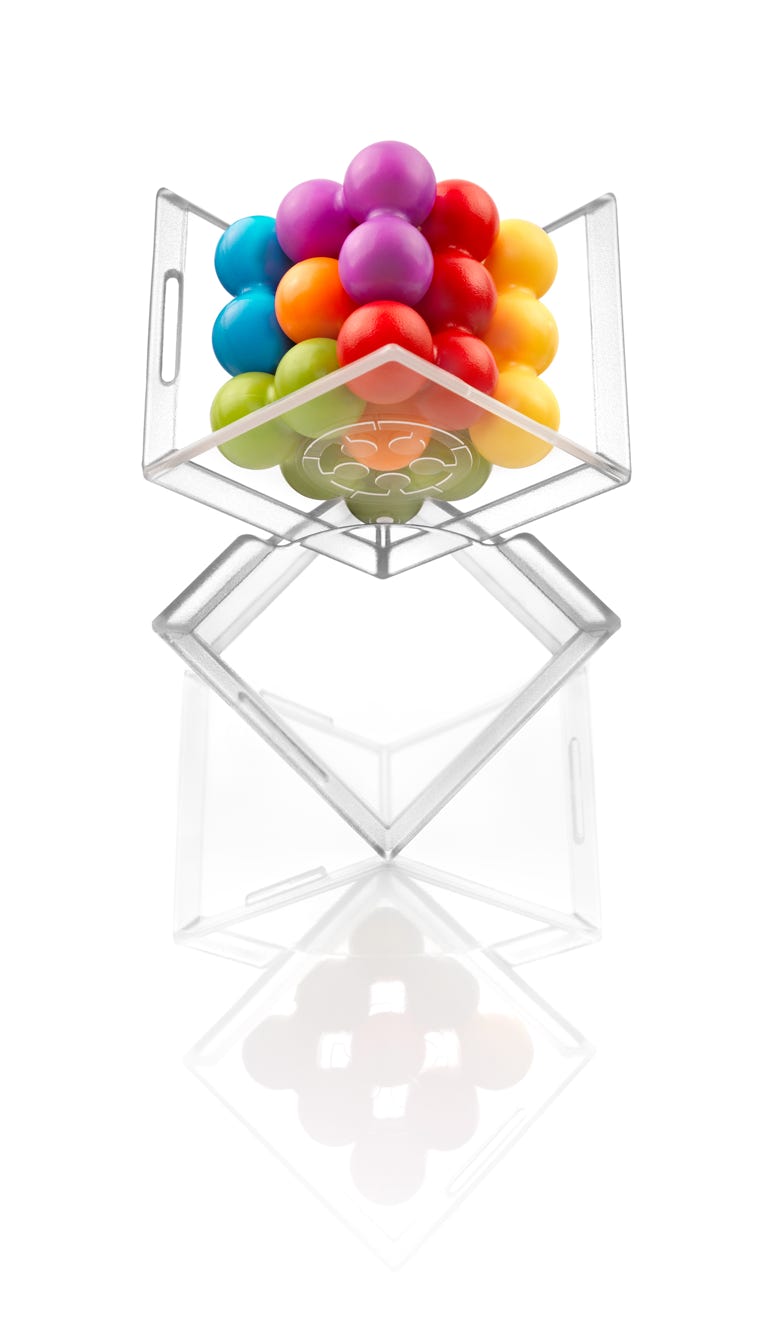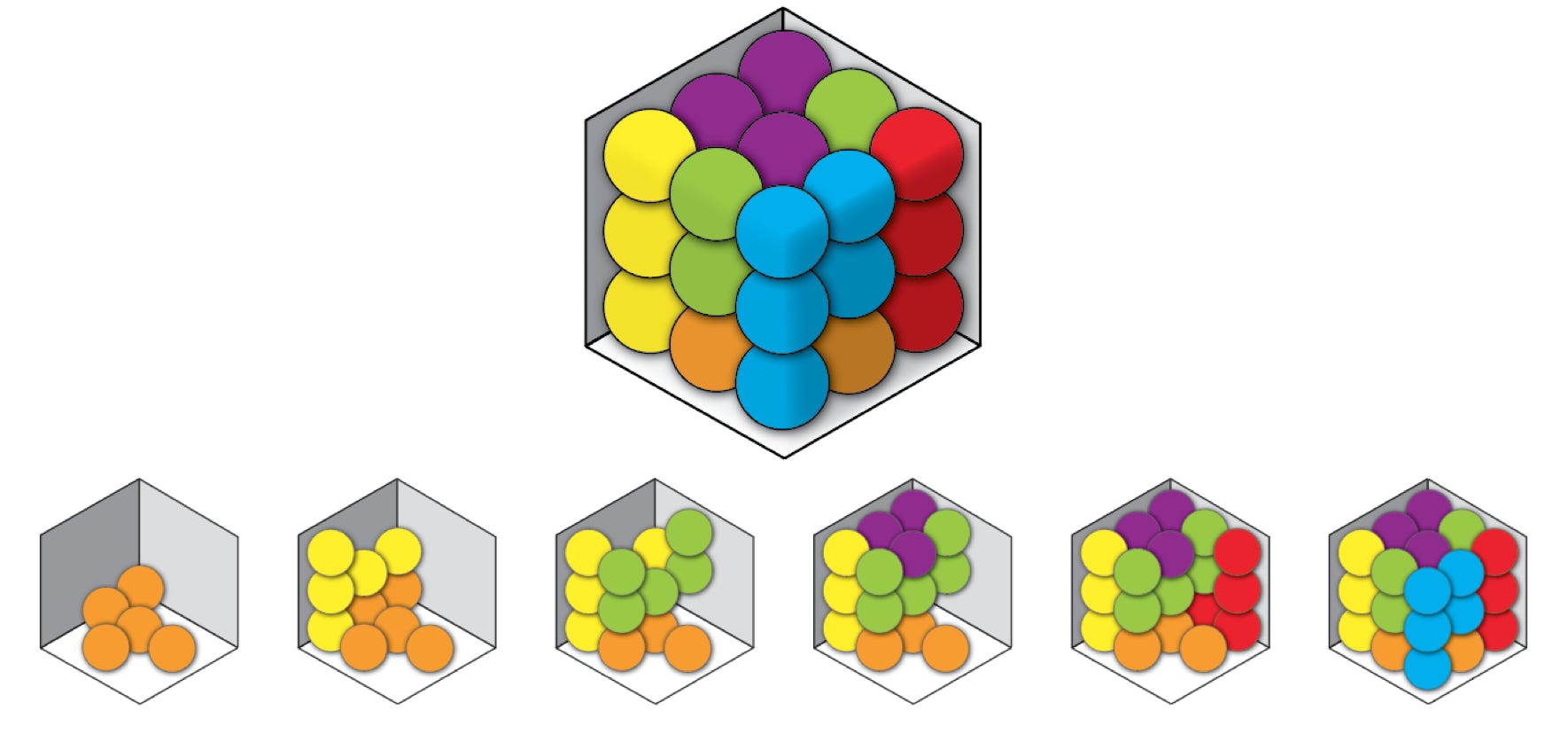
Cube Puzzler Pro


The story behind the creation of Cube Puzzler Pro
Raf Peeters, January 2018
After designing 7 IQ-games for SmartGames, I wanted to make something different but with the same strong points:
• simple rules
• abstract
• compact
What people like about IQ-Puzzler Pro, is that it has 3D challenges. They are quite difficult to solve, but the end result looks simple (a pyramid). The complexity of the challenge is hidden by the simplicity of the solution.
So, the objective for me was to create a compact 3D-puzzle that looked different to the existing IQ-games. One of the most simple looking 3D shapes is a cube, so I started there. The problem is that there are already many existing puzzles where the goal is to make or fill up a cube (for example the Bedlam Cube, Rubik’s Puzzle and Tetris Cube). And there is also an endless list of wooden assembly and interlocking puzzles in the shape of a cube.
A DIFFERENT CUBE
What could I do different? I started analyzing the existing products and came to following conclusions:
- They often use complicated puzzle pieces, combinations of smaller cubes that are not in the same plane. Or they use a lot of puzzle pieces. This makes them not suitable for beginners.
- They are often not practical to manipulate. Especially the products where the object of the game is to fill up a box. Once you start placing blocks inside this box, it’s hard to remove and to reposition them.
- The object is always to make a cube, without any other objectives. Therefor most games like that have only 1 challenge (which has often more than 1 solution).
- Many cubes are 4x4x4 or bigger, making them again too hard for beginners.
My search resulted first in Cube Puzzler Pro. I started using puzzle pieces from Quadrillion to build a 3x3x3 Cube. To make sure that everything stays balanced, the cube is tilted on one corner. This way 3 sides of the cube are at the bottom and pieces automatically fall to a stable position. The other 3 sides are at the topside and are open, so you can always easily manipulate the puzzle pieces.
Originally I wanted to make it a travel game. So the tray needed to double as a storage box. Therefor the tray is made of 2 parts. You can click them together to create a cube to store the puzzle pieces. If you want to play, you need to open the 2 parts of the transparent cube and assemble them differently, by pushing one corner of a part inside the cutout of the other part. You need to do this while holding one part in each hand and push until you hear a click, so that you create a solid tray. I kind of like the curved cutout in the cube. It gives the cube a distinct look, making it different from other cubes.
The object of the game is to create a cube, but not just any cube. The top view should show colors on specific positions. The easy challenges show all colors on the top view. So you see 3 adjacent sides of the cube. Harder challenges show only the color of a few balls. You need to figure out yourself what the color should be of the other balls (indicated in white in the challenge).
This way the concept becomes a little bit like a 3D version of IQ-Focus or and adult version of SmartCar 5x5. The funny thing about the top view, is that it looks like a hexagon. It’s like an optical illusion, it takes a while to see the cube instead of the hexagon, although the shadows I added help to see the 3D shapes.
It took a lot of different versions before I found the right combination of puzzle pieces. The final puzzle pieces include one piece that didn’t exist in Quadrillion (the red piece). You can combine the 6 puzzle pieces into 30 different ways to make a cube. But this cube can be rotated and mirrored 48 times. So you won’t see 2 solutions that are identical, although the game includes 80 challenges. The limited number of puzzle pieces make it possible to use deduction and logic to determine the correct position of each puzzle piece. This avoids that looking for the solution becomes a trail and error game.
Often the trick to solve a challenge is to find out the position of pieces that are not revealed in the challenge. Another trick is that it’s best to start with the puzzle pieces at the bottom. These are often the ones that need to be deducted, but if you start with the visible ones on the topside, you will soon find out that you don’t have enough hands to keep all balls in the air.
Although this was the first Cube Puzzler I developed, most people best start with the other one, which is simpler. Therefor this product was names “Cube Puzzler PRO” and the other one “Cube Puzzler GO”. You can read everything about the development of this second game on the next page.

example of a starter challenge/solution of Cube Puzzler Pro

example of a wizard challenge/solution of Cube Puzzler Pro

GAME RULES CUBE PUZZLER PRO
Before you start, create your game board:
Open the transparent case in 2 parts. Holding the parts in separate hands, push the corner of one part inside the gap of the other part to create a one-piece game board. The pieces are in place when you feel a “click.”
1) Choose a challenge.
- Starter challenges show 3 sides of the final cube on the topside.
- All other levels also show 3 sides of the final cube, but some information is missing (indicated by white circles).
2) Place the 6 puzzle pieces on the transparent tray to create a cube that stands on one of it’s corners. All 6 pieces must be used in each challenge.
3) You have found the correct solution when you have created a full cube, with the colours of the balls matching what is shown in the challenge. There is only 1 solution, which can be found at the end of the challenge booklet.
Hints
- When a challenge includes missing information about the colour of individual pieces, you may find the solution easier if you concentrate on the pieces you don’t see in the challenge, instead of only focusing on the pieces you can see.
- Build your cube from the bottom up. If information of the pieces at the bottom is missing, use logic and deduction to figure out which pieces belong there. If you try to build your cube from top to bottom, you will discover that you will not have enough hands to keep all puzzle pieces in place.
Website ©2018 Raf Peeters
Products and images: © Smart